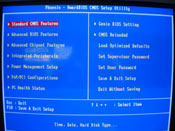DFI LanParty UT CFX3200-DR
Bios Features and Overclocking

DFI has outfitted the LANPARTY UT CFX3200-DR with a well equipped BIOS. Overclockers will be extremely pleased with the numerous tweaking options, as well as the amount of control it gives users over fan speeds and temperature/voltage information. One excellent feature is the ability to turn off the fan to your CPU heatsink if the CPU temperature is low enough. As we mentioned earlier, the chipset fan on the motherboard is fairly quiet, so that combined with the fan speed functions available through the bios could help users that are so inclined to build a much quieter system.
|
|
|



The "Genie BIOS" menu is where overclockers will likely spend most of their time, so let's take a closer look. Through the first section, you are given control over your HT Frequency(0-500), LDT/FSB Frequency Ratio, and CPU/FSB Frequency Ratio. A wide range of voltage settings have been included, allowing you to initially adjust the vCore from 0.8V to 1.55V. If that's not enough, you also have the option of adjusting the CPU VID Special Control, which provides VID + 101.4% to 121.6%. To help you get the most out of your memory, the DRAM Voltage Control goes from 2.06V, all the way up to a dangerous 4.15V.
Speaking of DRAM controls, DFI has also included a robust set of options to configure your DRAM settings. There's quite a few options to choose for your DRAM Frequency ratio. You're given a standard set of Tcl, Trcd, Tras, and Trp options, though you're also allowed to change quite a few other settings. To top off all the great memory tweaking features, there's also a Memory Tester program included in the BIOS, so there's no need to keep around a dusty old Memtest CD to check for stability after an aggressive overclock.
|
|
|
With all the overclocking options, we were eager to see just how far we could push this board, all the while maintaining stability. Once we loaded up the Genie BIOS, we immediately set our DRAM frequency to a 05/06 ratio so to remove any limitations of our memory. We kept the default 3-4-4-8 timings of our Corsair memory, and raised the voltage to 2.8v. We also lowered the LDT multiplier to x3, and our CPU multiplier to x7. From here, we started raising the HT frequency and occasionally tested for stability using Prime95's stability testing feature.
After a few hours of raising the HT frequency and testing for stability, we finally topped out around 321MHz. While we were able to occasionally boot into Windows when going beyond that, Prime95's stability test wouldn't last more than 5 minutes. We tried raising our CPU and DRAM voltage slightly to see if we could reach a higher, stable HT speed, however Prime95's stability test continued to fail.












